I heard this pre-power combination at the 2014 Bristol Sound and Vision Show in the Musical Fidelity Room, fed via a Musical Fidelity V90 DAC and playing through a pair of Spendor D7 loudspeakers. I thought the system sounded pretty darn good, so I made a mental note to review the pre and power amp – and the V90 DAC which was being used with them – after the show.
I soon found myself staggering across my home listening room clutching the M8-500s. When I say staggering, I mean it! This stereo power amp is a dual-mono power amp, with two entirely separate power amplifier circuits, power supplies, and 670VA mains transformers, which electrically share only the mains input. The transformers, power supplies, and heat-sinks (housing six bipolar transistors per channel), contribute to its substantial 29kg weight. This is a seriously heavy and bulky beast, but then it is rated at over 500W per channel into eight ohms.

The M8-500s Power Amp front view
It is a fully balanced design from input to output, with XLR inputs, and bridged outputs (in which both + and – binding posts are ‘live’). Unbalanced RCA sockets are provided for connecting unbalanced auxiliaries. The well tried and tested power amplifier topography traces its lineage back to the earlier KW and Titan models and is closely related to the more powerful M8500m monoblock. I have not auditioned the M8500m or the limited edition Titan, but admired the the KW 500, which was a very uncoloured and transparent amplifier with vanishingly low distortion; this rose only marginally at high frequencies, unlike many transistor amplifiers. It provided a smooth, uncoloured and confident, yet detailed delivery, with enormous power reserves. If the M8500s were to sound in the same ball park as the KW 500, I reasoned, this new design has the potential for greatness.
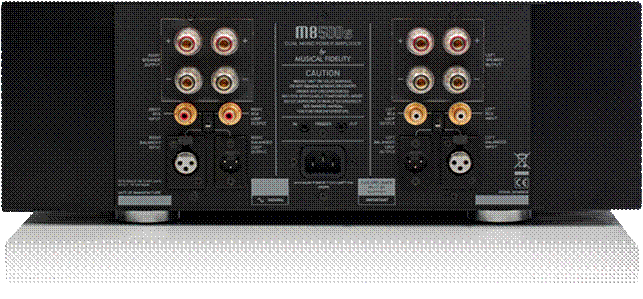
The M8-500s Power Amp rear view
The M8 PRE preamplifier, like the power amp, is also a fully-balanced design from input to output, but unbalanced phono inputs are of course provided for the inevitable unbalanced auxiliaries. Musical Fidelity say this is a Class A design, but Class A operation is commonplace in preamps; it is usually only power amplifiers where there is a need to use other classes of amplification to achieve higher power levels and minimise heat dissipation.
Preamps only deal with small signal sat relatively low power, and as the M8 PRE utilises tiny surface mount components tominimise signal paths, one might expect the preamplifier to be much lighter than the power amp. It is, but not by a lot. The M8 PRE weighs in at 17kg, which is no lightweight, due to a hefty 350VA transformer (enough for a sizeable power amp) and numerous regulated power supplies for different sections of the preamp. The idea of multiple stabilised power supplies is to keep different circuits as free from interaction as possible. So, combined with the very low claimed distortion and noise, one might expect something special from this preamp.
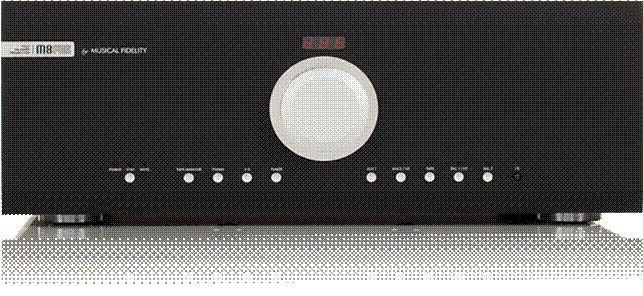
The M8 PRE Preamp front view
Unusually, these days, Musical Fidelity has provided a built-in phono pre-amplifier with provision for both moving magnet and moving coil cartridges. I am particularly pleased that Musical Fidelity has sensed the zeitgeist and included a proper phono stage, maybe because I was the first person to review Musical Fidelity’s first product, ‘The Preamp’ way back in 1982. It was a very fine, low-noise, transparent sounding preamp and it set Musical Fidelity on the path to its current success. Unlike most modern standalone high-end phono pre-amps, the input impedance is not user adjustable (it is set to 47k Ohms, with no capacitance selection), so one cannot play about with loading to fine tune the phono tonal balance for different MM and MC cartridges. Also, 47k Ohms, while OK for high output moving coils, is not ideal for those of low output, for which 100 Ohms would be more appropriate. It’s not a disaster by any means (as we shall see), but some choice would have been nice.
An unusual feature for a two-channel audiophile product is the provision, via slider switches on the rear, to convert one pair of balanced and one pair of unbalanced inputs to HT Inputs with unity gain. This is for use with multichannel processors in home cinema (Home Theatre) systems. Also rare these days is a genuine tape monitor switch.
The volume control and its LED readout sit above the long row of front mounted input buttons. The large knob controls a laser-trimmed resistive (analogue) attenuator with 0.5dB increments. Rather scarily, the knob must be rotated quite a few times before the display reads around 60 or more and playback reaches a usable level. The first time, I thought the amp was not working and I was nervous of what seemed like a high setting, but one soon gets used to it. At least one can turn the volume way down for late night listening without suddenly losing channel balance, which can happen with some old-style analogue potentiometers. A remote handset provides mastery over playback volume (including Mute) and also controls a Musical Fidelity CD player should you need one. The M8 PRE and M8-500s power amplifier are priced at close on $13,300 for the combination and, while that is a lot of money, I must say they really are very nicely put together.
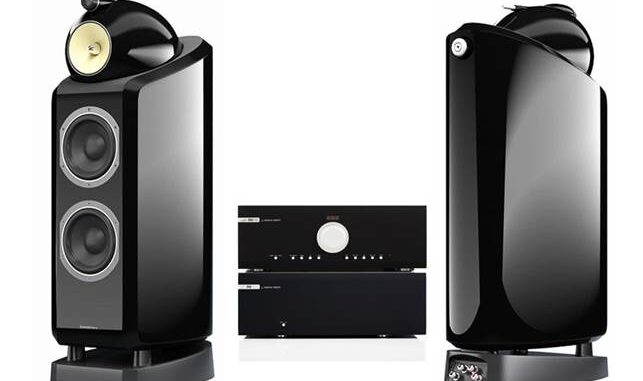
The M8 PRE and M8-500s power amplifier combination
For listening, I wired the Musical Fidelit y pre and power up to a Musical Fidelity V90 DAC fed via my Lenovo laptop with J. River Media Center 19. Further listening was carried out later on with vinyl replay using a Townshend Rock 7 with Origin Live Conqueror arm and Aladdin moving magnet cartridge.
Via the laptop, the sound quality of this preamp/power amp combo came across very much as I hoped and anticipated. The perceived transparency clarity and control were extremely impressive and music was delivered with a level of control and sure-footedness that is unusual. Initially, I wondered whether the delivery was just a fraction cold, dry or clinical, but, by virtue of the units warming up and running in, and trying many tracks and pieces of music, I realised that this pre/power combination, once run in and warmed up, is simply truthful. It merely transfers the source material as-is. It does not appear to add any character of its own – or if it does, it is vanishingly small.
It may sound like a cliché, but the M8 PRE and M8-500s sets the music free to speak for itself. One can try and coin phases such as depth, transparency, stereo imagery, control, smoothness, dynamics, precision, crispness, attack, and drama, but they cannot attempt to convey the way music seems to emerge effortlessly from a stable and silent background, without the clutter of extraneous stuff that can confuse the ears and brain.
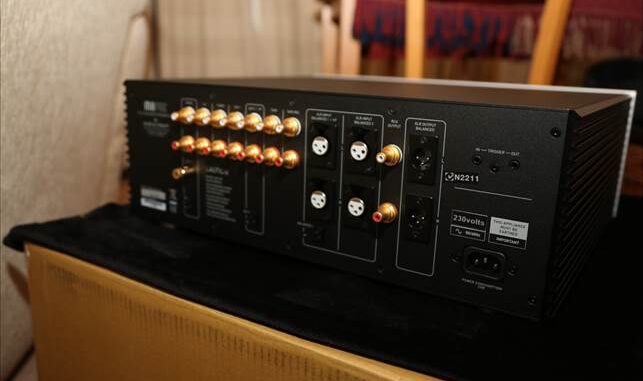
The M8 PRE Preamp rear view
Yes, the amplifier is very powerful – more than enough for most mortals – and bass is clean and tuneful, giving real power and depth when required, but it is the amplifier’s ability to simply go with the flow that is most impressive.
At the other end of the spectrum, cymbals and high hats are crisp and dynamic, even on some old analogue recordings, where one might expect something more muted, and massed or solo strings are sweet or ‘stringy’ as recorded.
I played Kodaly’s Dances of Galenta [Linn Records/Scottish Symphony Orchestra]. This CD layer rip may not quite match the sense of occasion and space of the SACD recording from which it is derived, but Musical Fidelit y’s rendition of it preserved the lush, expansive, sweet string sound of the original. Reproduction was never harsh, but very transparent and enjoyable. Playing Courtney Pine’s ‘Get Busy’ from his CD Closer To Home [Island] highlighted the well-paced bass delivery of the Musical Fidelit y pre and power combo, with the deep powerful driving bass rhythms on this track conveyed brilliantly, while the rich reedy sound of his saxophone sat well in the mix, together with studio-added reverberation.
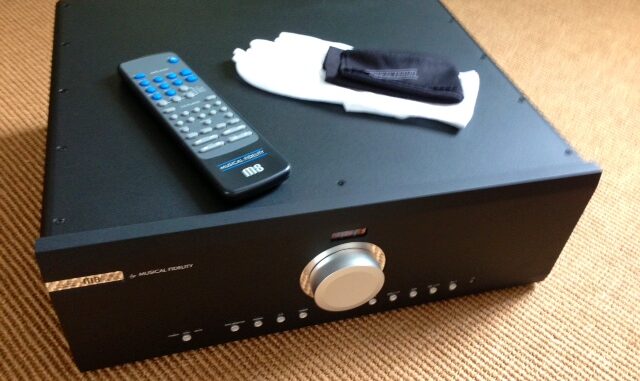
M8 PRE Preamp and remote control
However, don’t expect this Musical Fidelity pair to paper over the cracks and smooth out rough old recordings, as if viewed by a soft focus lens. This is no valve amp clone. If there is an artificial edge, or roughness in the recording, it will be clear – just as surely as some subtle hints of reverberation or layers in a mix, or noises you never heard so clearly before. This combo will reproduce all and, of course, it is not always nice. Honest, yes; euphonic, no. For example, Joni Mitchell’s LP Blue [Reprise], recorded with the intention of capturing a raw edge: it still has it even in the re-mastered version which I ripped to hard disc. Yes, it still sounds raw, but the Musical Fidelity is honest to it – still a great classic album nonetheless.
My vinyl experience largely mirrored the USB DAC one, with the added dimensions that pure analogue brings, but not until overcoming one obstacle – hum harmonics. With both the Townshend/Conqueror/Aladdin and also a Clearaudio DC turntable with MM cartridge, there was very noticeable hum, so bad that it made listening unacceptable. Yet this had not been audible before with other, stand-alone pre-amps. Initially, I had to use an external phono preamp and so I pressed a Creek OBH15 into service. Clearly something was not quite right. I fixed the problem eventually by grounding the tone-arm earth tag to one of the screens of the M8 PRE phono inputs, which removed the hum completely and totally transformed the listening experience. From then on I could hear and enjoy the remarkably fine performance proved by the on board M8PRE’s MM phono pre amplifier.
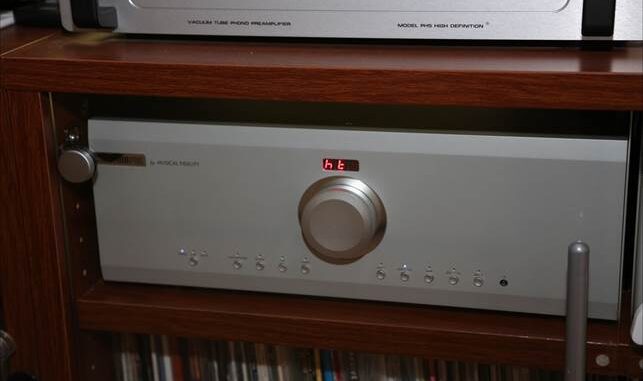
The M8 PRE Preamp silver edition
For instance, in the quietly evocative introduction to Stravinsky’s Rite of Spring [Berlin Philharmonic/Von Karajan, DG] the instruments were clear and pure against a relatively silent background (a nice clean copy of this LP), the only noise being the barely detectable whisper of vinyl under stylus. As the music built to include jabbing horns, pounding drums and crashing percussion in the Dance of the Earth, the instruments remained well separated.
Playing the CBS LP Miles Davis with John Coltrane via the M8 PRE, again with internal phono pre-amplifier, I was struck by the clarity and richness of Coltrane’s Sax, Wynton Kelly’s clear, full-toned, expressive piano, and Miles’ distinctive trumpet playing. This 1974 compilation of early 60’s recordings was a delight to hear.
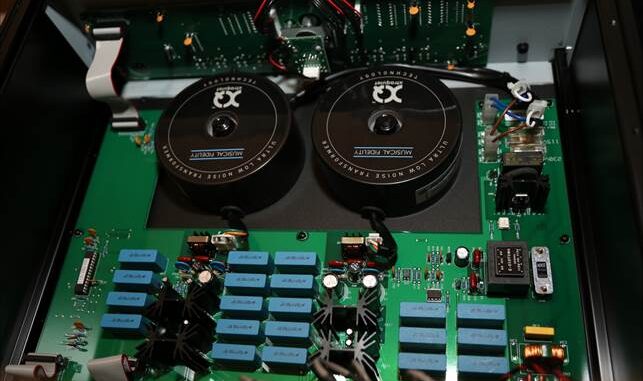
Inside the M8 PRE Preamp
Going to another extreme, take Jimmy Hendrix’s ‘Purple Haze’ (180 gram Hendrix Family authorised ‘Audiophile’ pressing of The Jimmy Hendrix Experience). Its raw energy, distorted guitars and driving bass lines were reproduced clearly with all their edgy roughness. Then, an original LP of the Beatles’ Sgt. Pepper’s Lonely Hearts Club Band [Parlophone] found its way onto the platter. It sounded particularly well, with excellent vocal clarity, bass power and definition and clean treble – a really enjoyable listening experience.
Not only is the preamp extremely quiet, but is is also remarkably transparent and lacking in any additional harshness, coloration or artificial brightness. Using the phono MM input, vocals sounded smooth and natural, while bass was, deep, well paced, and powerful – and all from a quiet background without exaggeration of clicks, pops, or surface noise. Vinyl of all sorts sounded highly satisfying. Indeed, I have rarely heard this turntable and arm with Aladdin cartridge sound this well balanced and accomplished.
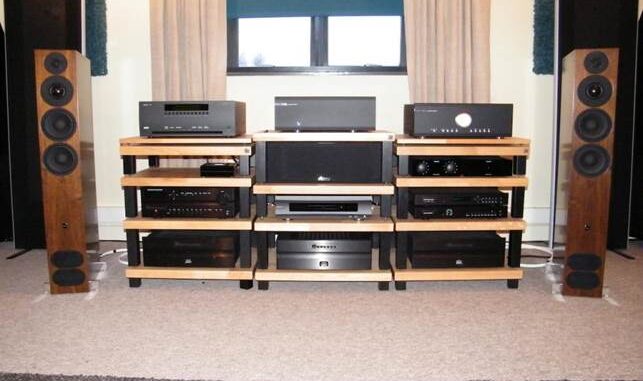
The M8PRE and M8-500s at a sound test
So, in the final analysis, did I like the M8PRE and M8-500s? You bet I did, but as with any piece of audiophile hi-fi, system matching is the key and one must of course audition before deciding. It is a sweet sounding combo, but if there is distortion, brittleness, or sharpness in the source signal the Musical Fidelity will reproduce it. The tonal balance is as neutral as you are likely to find in a transistorised amplifier, and the power and control over the speakers is prodigious. More importantly, it frees the music.
